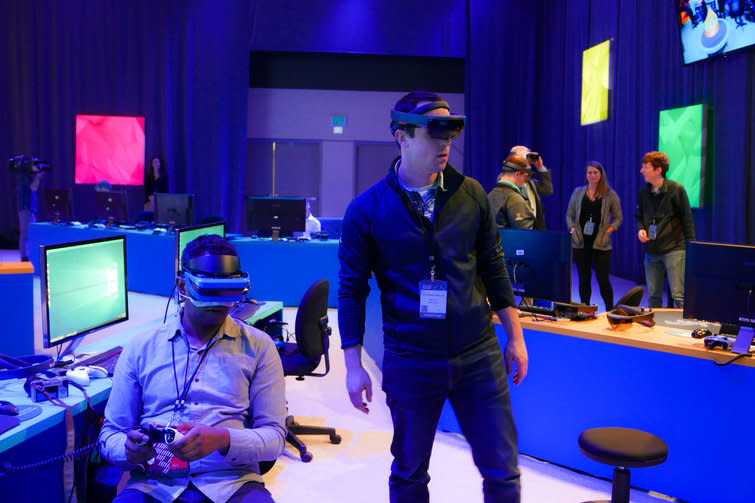I Got Lost in a World Where VR and HoloLens Collide
SEATTLE — AR or VR? Why not both?
At its Build developer conference in Seattle, Microsoft used its Mixed Reality Academy to teach coders how to make apps for both HoloLens and Windows 10 headsets. In an abbreviated version of the course, I was able to go hands-on and try a game from both perspectives.

An Acer headset (left) and HoloLens (right) being used in concert. Credit: Andrew E. Freedman / Tom's Guide
The new name (it was formerly Holographic Academy) is a shift for Microsoft, which previously taught coders exclusively for HoloLens. In the demonstration, we enabled the code to run both headsets.
That’s where the magic began. On an Acer Mixed Reality Headset, I played through a VR experience in which I solved puzzles on an island to approach a secret rocket ship hidden in the volcano. My compatriots, using HoloLens, could see where I was located on the island in a hologram and were able to see where I was and give me clues. They were also able to shoot lightning bolts at me, because omnipotent beings are never simply benevolent.
It was a puzzle that was easy to solve because of teamwork, and it was new and refreshing to play one game with multiple tools.
Being in Acer’s headset wasn’t any different from using a VR headset, minus its lenses, which aren’t as good as more expensive headsets. But HoloLens was where the demo shined, as I could see the entire island from any point and see their progress in real time.
MORE: I Jumped Off a Building In a Windows MR Headset
What was perhaps most enlightening was just how much code (and I didn’t code, I just checked some boxes and hit save a bunch) goes into making sure an app — the same app — can run on both an HMD and a HoloLens. These are Universal Windows Platform apps, so they’re designed to run on any Windows device, meaning even if you can’t afford a HoloLens, you can still use it in VR.
And HoloLens is far from consumer viability. A developer kit is $3,000 and the enterprise version is $5,000. Acer’s headset, as well as those from HP and other vendors, are scheduled to release this fall starting at $299, a much more palatable price.
But using HoloLens to augment someone else’s VR experience was new and refreshing, and I can’t help but wait for more people to be able to get their hands on both to see how magical it is.



